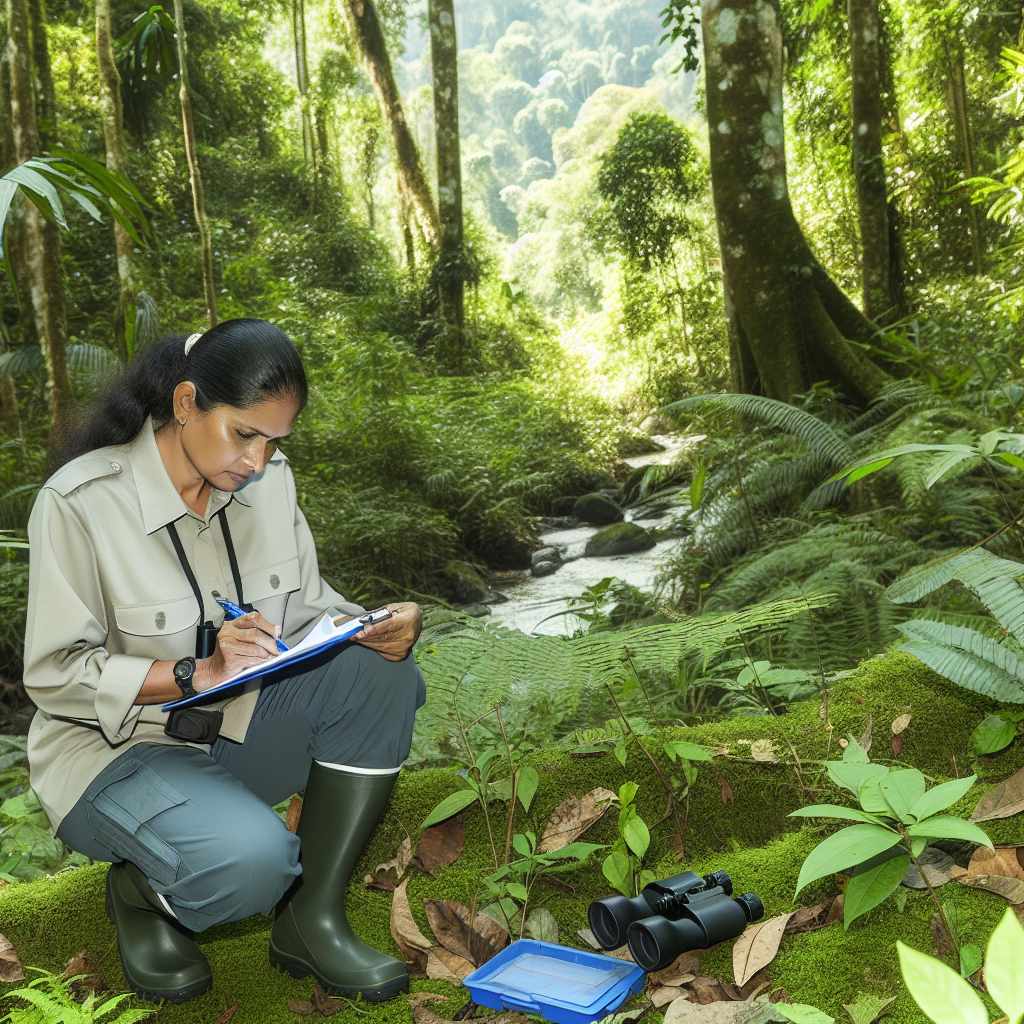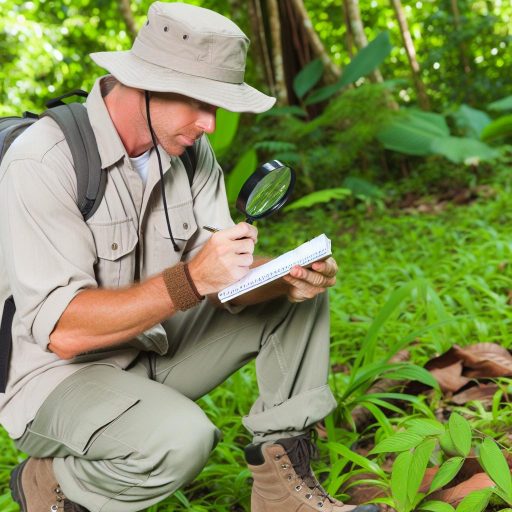Forests play a crucial role in maintaining biodiversity and ecosystem services for conservationists.
Proper forest management is essential for sustaining these valuable resources.
Importance of Forest Management
Conservationists aim to protect and preserve forests’ ecological integrity, wildlife habitats, and water quality through effective management practices.
Forest Management Techniques
- Sustainable harvesting: Harvesting timber and non-timber forest products in a way that maintains forest health and productivity.
- Ecological restoration: Rehabilitating degraded forest areas to enhance biodiversity and ecosystem functions.
- Fire management: Implementing controlled burns to reduce fuel loads and prevent catastrophic wildfires.
- Invasive species control: Managing invasive species to prevent them from outcompeting native vegetation.
- Wildlife habitat improvement: Creating and maintaining habitats for endangered species within forests.
- Water resource protection: Implementing measures to safeguard water quality and quantity in forested watersheds.
Each of these techniques requires careful planning and execution to achieve conservation goals while meeting social and economic needs.
Sustainable Harvesting
Definition and Benefits
Techniques: Selective Cutting, Shelterwood Harvesting
Importance for Long-term Forest Health
Definition and Benefits
Sustainable harvesting is the practice of harvesting forest resources in a way that allows the ecosystem to regenerate naturally.
This method ensures that the forest can continue to provide resources for future generations.
One of the key benefits of sustainable harvesting is that it helps maintain biodiversity within the forest.
By selecting specific trees for harvest and leaving others untouched, this technique allows different species to thrive.
It ensures a healthy ecosystem.
Techniques: Selective Cutting, Shelterwood Harvesting
Selective cutting involves carefully choosing which trees to harvest based on factors such as age, size, and species.
This method helps maintain the overall structure and composition of the forest.
Additionally, it promotes the growth of younger trees.
Shelterwood harvesting is another technique used in sustainable forest management.
This method involves removing older trees in stages.
It gradually opens the canopy to allow sunlight to reach the forest floor and promotes the growth of new seedlings.
Importance for Long-term Forest Health
Implementing sustainable harvesting practices is crucial for the long-term health of forests.
By ensuring that only a portion of trees are harvested at a time, the ecosystem is able to regenerate and remain in balance.
Transform Your Career Today
Unlock a personalized career strategy that drives real results. Get tailored advice and a roadmap designed just for you.
Start NowOverharvesting can lead to serious consequences such as soil erosion, loss of wildlife habitats, and decreased biodiversity.
Sustainable harvesting helps prevent these issues and maintains the overall health of the forest ecosystem.
Reforestation and Afforestation
Forests play a crucial role in maintaining ecological balance and supporting biodiversity.
However, due to deforestation and other human activities, forest cover is rapidly declining.
This makes reforestation and afforestation essential practices for conservationists to restore and expand forest areas.
Importance of Reforestation and Afforestation
Reforestation involves planting trees in areas where forests have been cleared or destroyed.
Afforestation refers to establishing new forests in areas that were not previously forested.
These practices are vital for increasing forest cover and mitigating the negative impacts of deforestation.
Reforestation and afforestation help in restoring ecosystem services, such as carbon sequestration, water regulation, and habitat preservation.
These practices also enhance biodiversity by creating suitable habitats for various plant and animal species.
Techniques for Successful Reforestation and Afforestation Projects
- Site Selection: Choose suitable locations based on soil quality, climate conditions, and proximity to water sources.
- Species Selection: Select native tree species that are well-adapted to the local environment and support biodiversity.
- Preparation: Clear the site of invasive species, debris, and weeds to provide a suitable environment for tree growth.
- Planting: Follow proper planting techniques, such as digging appropriate holes, ensuring proper spacing, and providing adequate water and nutrients.
- Maintenance: Implement regular monitoring, watering, weeding, and pest control to support tree growth and survival.
Examples of Successful Reforestation and Afforestation Projects Worldwide
The Great Green Wall in Africa aims to combat desertification by planting a wall of trees across the Sahel region.
The Billion Tree Tsunami project in Pakistan has successfully planted billions of trees to combat deforestation and climate change.
The Bonn Challenge is a global effort to restore 350 million hectares of degraded and deforested land by 2030.
The Reforest Patagonia project in Chile has planted millions of trees to restore degraded landscapes and support biodiversity.
The Loess Plateau Watershed Rehabilitation Project in China has transformed barren slopes through afforestation, improving soil fertility and water retention.
Delve into the Subject: Exploring Job Opportunities in Horticulture
Invasive Species Control
Explanation of invasive species and their impact on forest ecosystems.
Invasive species are non-native plants, animals, or pathogens that disrupt the natural balance of an ecosystem.
They often outcompete native species for resources, leading to a decline in biodiversity.
Showcase Your Business Today
Reach thousands of readers actively exploring professional services. Publish your business profile and grow your audience now.
Publish NowTechniques for controlling invasive species such as mechanical removal and herbicide application.
Mechanical removal involves physically removing invasive species from an area, such as cutting or uprooting them.
This method is effective for large plants or trees that can be easily accessed.
Herbicide application is another common technique used to control invasive species.
Herbicides target specific plants, reducing their growth and spread without harming native species.
Importance of invasive species control in maintaining biodiversity.
Controlling invasive species is crucial for maintaining biodiversity in forest ecosystems.
Invasive species can outcompete native plants and animals, leading to a loss of habitat and food sources for native species.
By managing invasive species, conservationists can help preserve the delicate balance of ecosystems.
This effort protects the diversity of plant and animal life.
Find Out More: Extension Agents and Environmental Stewardship
Forest fires are a major concern for conservationists due to their devastating impact on forest ecosystems.
Overview of Forest Fires and Their Impact on Forest Ecosystems
Forest fires can lead to loss of biodiversity, destruction of habitats, and release of carbon dioxide into the atmosphere.
Techniques for Preventing and Managing Forest Fires
One effective method is prescribed burning, which involves controlled burning to reduce fuel buildup.
Creating firebreaks, which are clearings or barriers that can stop or slow down the spread of fires.
Importance of Forest Fire Management for Conservationists
Proper forest fire management is crucial for conservationists to maintain healthy forest ecosystems.
It helps prevent catastrophic wildfires, protects wildlife, and ensures the sustainability of forests.
By implementing fire management techniques, conservationists can promote biodiversity and preserve natural habitats.
Discover More: Famous Entomologists Who Changed Agricultural Practices

Wildlife Habitat Improvement
Creating suitable habitats for wildlife within forest ecosystems is vital for conservationists to ensure the survival of various species.
In this section, we will discuss the importance of providing wildlife habitats and explore techniques for improving these habitats.
Importance of Providing Suitable Habitats
Wildlife habitats in forests play a crucial role in supporting biodiversity and ecological balance.
When natural habitats are disrupted or destroyed, wildlife populations decline, leading to potential extinctions.
By enhancing and creating suitable habitats, conservationists can help preserve wildlife populations and promote a healthy ecosystem.
Techniques for Improving Wildlife Habitat
There are several techniques that conservationists can use to enhance wildlife habitats in forest ecosystems.
One effective method is to create snags, which are standing dead trees with cavities that provide shelter, nesting sites, and food sources for birds, mammals, and insects.
Another technique is to build brush piles using fallen branches and debris, which provide cover and foraging opportunities for various wildlife species.
Examples of Successful Projects
- Creating Snag Forests: In some regions, conservationists have successfully established snag forests by leaving standing dead trees in designated areas. This initiative has attracted a variety of bird species, including woodpeckers and owls, which rely on snags for nesting and feeding.
- Building Brush Piles: Wildlife habitat improvement projects involving the construction of brush piles have proven to be effective in enhancing biodiversity. These brush piles provide hiding spots for small mammals, reptiles, and amphibians, creating a diverse habitat structure within the forest ecosystem.
- Restoring Riparian Zones: Conservation efforts to restore riparian zones along water bodies have led to the revival of aquatic and terrestrial wildlife species. By planting native vegetation, maintaining healthy stream banks, and controlling invasive species, conservationists have improved habitat quality for a variety of wildlife, including fish, amphibians, and waterfowl.
Wildlife habitat improvement projects are essential for conservationists to protect and enhance forest ecosystems.
By implementing effective techniques and initiatives, conservationists can contribute to the preservation of biodiversity and the sustainability of wildlife populations.
You Might Also Like: Agricultural Technician Work Environments
Soil Conservation Practices
Soil erosion and degradation are serious issues in forest ecosystems.
This can lead to loss of fertile soil, reduced productivity, and negative impacts on biodiversity.
Explanation of soil erosion and degradation in forest ecosystems: Soil erosion is the process by which soil is removed from its original location by wind or water.
Degradation refers to the decline in quality of soil due to various factors including erosion, compaction, and loss of nutrients.
Techniques for soil conservation: Conservationists use various methods to prevent soil erosion and degradation in forest ecosystems.
Contour plowing involves planting crops along the natural contours of the land to reduce water runoff and soil erosion.
Cover cropping involves planting crops that cover the soil surface, protecting it from erosion and improving soil health.
Importance of soil conservation for maintaining healthy forests: Soil conservation practices are essential for maintaining the health and productivity of forest ecosystems.
Healthy soil supports the growth of trees, plants, and wildlife, contributing to overall ecosystem health and biodiversity.
By implementing soil conservation techniques, conservationists can help to prevent erosion, sustainably manage forests, and protect natural resources for future generations.
Showcase Your Business Today
Reach thousands of readers actively exploring professional services. Publish your business profile and grow your audience now.
Publish NowEssential Techniques for Forest Conservation
As we have discussed, forest management techniques are essential for conservationists to protect and preserve forest ecosystems.
It is crucial for conservationists to implement sustainable forest management practices in order to ensure the longevity of these valuable resources.
By employing proper techniques such as selective logging, controlled burns, and reforestation efforts, conservationists can help maintain the health and diversity of forests.
Through careful planning and monitoring, conservationists can mitigate the negative impacts of deforestation, habitat loss, and climate change on forest ecosystems.
Ultimately, the importance of forest management techniques cannot be overstated, as they play a vital role in promoting biodiversity, protecting wildlife habitats, and sustaining the overall health of our planet.
It is up to conservationists to take action and make a difference in the way we manage and conserve our forests for future generations.
Together, we can work towards a more sustainable future where forests are thriving and continue to provide a wealth of benefits for all living organisms on Earth.
Additional Resources
[E-Books for Sale]
The Big Book of 500 High-Paying Jobs in America: Unlock Your Earning Potential
$19.99 • 500 High-Paying Jobs • 330 pages
Explore 500 high-paying jobs in America and learn how to boost your career, earn more, and achieve success!
See All 500 High-Paying Jobs of this E-Book
1001 Professions Without a Degree: High-Paying American Jobs You Can Start Now
$19.99 • 1001 Professions Without a Degree • 174 pages
Discover 1001 high-paying jobs without a degree! Unlock career tips, skills, and success strategies for just $19.99!




